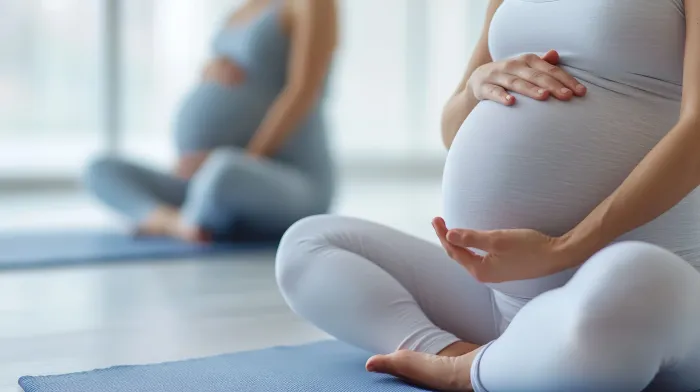A Guide to Yoga and Physiotherapy for a Healthy, Comfortable Pregnancy
Know about the role of yoga and physiotherapy in pregnancy, why your body needs it, types, and benefits of both in pregnancy, power of combination and your wellness plan.

Written by Dr. J T Hema Pratima
Reviewed by Dr. Dhankecha Mayank Dineshbhai MBBS
Last updated on 5th Oct, 2025

Introduction
Pregnancy is a beautiful journey marked by incredible physical and emotional changes. While exciting, these changes from a shifting centre of gravity to hormonal fluctuations can often bring discomfort, pain, and anxiety. Many expectant mothers are now turning to holistic approaches to manage these challenges, and two powerful allies stand out: yoga and physiotherapy. This guide explores how integrating these practices can help you not just cope, but thrive throughout your pregnancy. You'll learn about safe exercises for each trimester, how to strengthen your body for labour, and ways to cultivate mental calm. Remember, while these practices are highly beneficial, it's crucial to consult your doctor or a specialist from Apollo24|7 before beginning any new regimen to ensure it's tailored to your unique needs. Let’s embark on this path to a more comfortable and empowered pregnancy.
Understanding Your Body's Transformation During Pregnancy
To effectively use yoga and physiotherapy, it's essential to understand why your body feels the way it does. Pregnancy triggers a series of deliberate, yet challenging, adaptations.
Consult Top Specialists for Personalised Tips
The Musculoskeletal Shift: Posture, Spine, and Pelvis
As your baby grows, your uterus expands, shifting your centre of gravity forward. To compensate, you may unconsciously lean back, increasing the curve in your lower spine (lordosis). This places significant strain on the lumbar vertebrae, back muscles, and ligaments, leading to the common complaint of lower back pain. Meanwhile, the pelvis begins to prepare for birth. The sacroiliac joints at the base of your spine can become more mobile, sometimes resulting in sacroiliac joint pain or Pelvic Girdle Pain (PGP). A prenatal physiotherapist can assess your posture and provide specific exercises to stabilise these areas, while yoga promotes awareness and alignment to counteract these strains.
Hormonal Changes and Their Impact on Joints and Tissues
The hormone relaxin increases dramatically during pregnancy. Its job is to soften and loosen ligaments, particularly in the pelvis, to allow for childbirth. However, relaxin doesn't discriminate; it affects ligaments throughout the body. This increased laxity can make you more prone to joint sprains and instability. This is a key reason why safe yoga poses for each trimester emphasise stability over deep, passive stretching. Understanding this hormonal influence helps explain why a previously easy yoga pose might now feel different and require modification.
Yoga in Pregnancy: More Than Just Stretching
Prenatal yoga is a tailored practice designed to support your changing body. It’s a multifaceted tool that offers profound benefits.
The Triad of Benefits: Physical, Mental, and Emotional
The triad benefits are:
- Physically, yoga builds functional strength in the legs, back, and arms, which are essential for carrying your baby and for labour. It improves circulation, reducing swelling in the ankles and feet, and can alleviate common aches.
- Mentally, the focus on breathwork (pranayama) is a powerful tool for managing stress and anxiety. It teaches you to stay calm under discomfort, a skill directly transferable to managing labour pains.
- Emotionally, connecting with your body and your growing baby in a positive, mindful way fosters a deep sense of empowerment and well-being.
Safe Yoga Poses for Each Trimester
A one-size-fits-all approach doesn't work in pregnancy. Your practice should evolve with your body.
First Trimester Focus: Energy and Stability
Focus on gentle poses that build foundation and combat fatigue. Avoid intense twists or poses on your belly.
- Cat-Cow Pose: Marvellous for warming up the spine and relieving early back tension.
- Goddess Squat (Malasana): Builds leg strength and opens the hips gently.
- Supported Standing Poses: Like Warrior II, using a chair for balance.
Second Trimester Focus: Strength and Alignment
This is often when energy returns. Focus on building strength and improving posture as your bump grows.
- Modified Triangle Pose (Trikonasana): Excellent for stretching the sides of the torso and strengthening the legs.
- Bridge Pose (Setu Bandhasana): Strengthens the glutes and hamstrings, supporting the lower back.
- Prenatal Sun Salutations: A flowing sequence to build cardiovascular health.
Third Trimester Focus: Comfort and Preparation for Labour
Priority shifts to comfort, hip opening, and relaxation. Use plenty of props (bolsters, pillows).
- Supported Child’s Pose: A restorative pose for relieving backache and calming the mind.
- Pelvic Tilts on a Birth Ball: Gently mobilises the spine and pelvis.
- Deep Breathing Practices: Focus on full, diaphragmatic breaths to prepare for labor.
Poses to Avoid and Essential Safety Tips
- Avoid: Deep backbends, intense twists, poses lying flat on your back after the first trimester (can restrict blood flow), jumps, and any pose that causes pain or pressure in the abdomen.
- Listen to Your Body: This is the golden rule. If something doesn’t feel right, stop. Hydrate well and practice in a cool, well-ventilated space.
Physiotherapy in Pregnancy: Your Guide to Pain Relief and Recovery
While yoga offers broad wellness benefits, physiotherapy provides targeted, clinical solutions to specific problems.
Tackling Common Pregnancy Ailments: Back Pain, SPD, and Incontinence
A physiotherapist specialising in women’s health can diagnose the exact cause of your pain. For instance, back pain could be muscular, related to a joint, or due to pelvic girdle pain. Treatment may include:
- Manual therapy to mobilise stiff joints.
- Specific strengthening exercises for underactive muscles (like glutes).
- Taping to support the abdomen or pelvis.
- Advice on ergonomics for sleeping, sitting, and lifting.
Pelvic Floor Physiotherapy: The Key to Labour and Postpartum Health
The pelvic floor muscles are a hammock of support for your bladder, uterus, and bowels. Pregnancy and childbirth can weaken them. Pelvic floor physiotherapy involves learning to correctly contract and, just as importantly, relax these muscles. Proper relaxation is crucial for allowing the baby to descend during the second stage of labour. A physiotherapist can teach you these skills, helping to prevent or treat incontinence and prepare your body for a more efficient birth. If you experience persistent leakage or heaviness, consulting a specialist via Apollo24|7 can provide a clear path to management.
Core Strengthening and Diastasis Recti Prevention
Traditional ab exercises like crunches are not advisable during pregnancy as they can increase intra-abdominal pressure and contribute to diastasis recti (the separation of the abdominal muscles). A physiotherapist teaches safe core engagement techniques that focus on the deep transverse abdominis muscle, which acts like a natural corset, supporting your back and baby bump without causing harm.
The Powerful Synergy: Combining Yoga and Physiotherapy
The real magic happens when you combine the mindful movement of yoga with the precise, corrective approach of physiotherapy.
How a Physiotherapist Can Inform Your Yoga Practice
Imagine going to a yoga class with personalised knowledge. A physiotherapist’s assessment can tell you:
- "Your gluteus medius is weak, so focus on engaging it in standing poses like Warrior II."
- "You tend to overstretch your ligaments, so avoid pushing into your joints in poses like Downward Dog."
- "Your pelvic floor is tight, so prioritise relaxation breaths in hip-opening poses."
This transforms your yoga practice from a general workout into a targeted therapy session.
Creating a Personalised Wellness Plan
An integrated approach might look like this: you see a physiotherapist once a month for assessment and targeted exercises for, say, pregnancy-induced sciatica. Meanwhile, you attend a prenatal yoga class twice a week to maintain overall strength, flexibility, and mental calm, consciously applying the cues from your physio during the practice. This creates a comprehensive prenatal wellness plan that addresses both prevention and intervention.
Conclusion
Navigating the physical changes of pregnancy can be one of its biggest challenges, but it doesn't have to be a struggle. By understanding the "why" behind the changes and proactively using the tools of yoga and physiotherapy, you can build a resilient, comfortable, and empowered body. Yoga offers the holistic framework for mental and physical wellness, while physiotherapy provides the clinical precision to address specific ailments. Together, they form a powerful synergy that supports you from the first trimester through to labour and beyond. If at any point you experience pain that doesn't resolve with these methods, remember that professional help is readily available. You can easily book a physical visit or an online consultation with a women's health physiotherapist or specialist through Apollo24|7 to get personalised care.
Consult Top Specialists
Consult Top Specialists for Personalised Tips

Dr Syed Mateen Pasha
General Physician
2 Years • MBBS
Bengaluru
PRESTIGE SHANTHINIKETAN - SOCIETY CLINIC, Bengaluru

Dr. Abhirup Chakrabarti
General Practitioner
10 Years • MBBS
Chennai
Dr Abhirup Chakrabarti, Chennai

Dr. Riti Srivastava
General Practitioner
12 Years • MD (Physician)
Gautam Buddha Nagar
Shri Krishna Clinic, Gautam Buddha Nagar

Dr. Avinash Pasuparthy
General Practitioner
5 Years • MBBS
Visakhapatnam
Apollo Clinic Vizag, Visakhapatnam

Dr. Gunashree V L
General Physician/ Internal Medicine Specialist
3 Years • MBBS
Bengaluru
Apollo Clinic, JP nagar, Bengaluru
Consult Top Specialists

Dr Syed Mateen Pasha
General Physician
2 Years • MBBS
Bengaluru
PRESTIGE SHANTHINIKETAN - SOCIETY CLINIC, Bengaluru

Dr. Abhirup Chakrabarti
General Practitioner
10 Years • MBBS
Chennai
Dr Abhirup Chakrabarti, Chennai

Dr. Riti Srivastava
General Practitioner
12 Years • MD (Physician)
Gautam Buddha Nagar
Shri Krishna Clinic, Gautam Buddha Nagar

Dr. Avinash Pasuparthy
General Practitioner
5 Years • MBBS
Visakhapatnam
Apollo Clinic Vizag, Visakhapatnam

Dr. Gunashree V L
General Physician/ Internal Medicine Specialist
3 Years • MBBS
Bengaluru
Apollo Clinic, JP nagar, Bengaluru
More articles from General Medical Consultation
Frequently Asked Questions
When is the best time to start prenatal yoga?
You can start as early as your first trimester, provided you have your doctor's approval. However, many women prefer to wait until after the 12-week mark when energy levels may be more stable.
I have never done yoga before. Is it safe to start during pregnancy?
Yes, it is safe to begin, but it is crucial to join a class specifically labelled 'Prenatal Yoga.' These classes are designed for beginners and focus exclusively on safe poses and modifications for pregnant women.
What is the difference between a regular yoga class and a prenatal one?
Prenatal classes avoid poses that are risky during pregnancy (like deep twists or lying on the belly), use more props for support, focus on breathing techniques for labour, and often include more pelvic floor work.
Can physiotherapy really help with severe back pain in the third trimester?
Absolutely. A women's health physiotherapist can identify the specific cause of your back pain (e.g., joint dysfunction, muscle strain) and provide hands-on treatment, specific exercises, and advice on support belts or taping that can offer significant relief.
Is it too late to start physiotherapy if I'm already 36 weeks pregnant?
It is never too late. Even a single session can provide valuable techniques for pain management, optimal fetal positioning, and preparation for labour, particularly regarding pelvic floor relaxation.


.webp)

